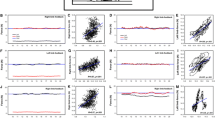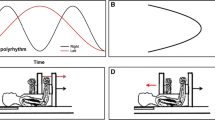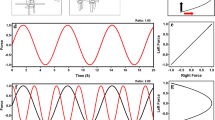Abstract
To elucidate the neural interactions underlying bimanual coordination, we investigated in 11 participants the bilateral coupling of homologous muscles in an isometric force production task involving fatiguing elbow flexion and extension. We focused on changes in motor unit (MU) synchronization as evident in EMG recordings of relevant muscles. In contrast to a related study on leg muscles, the arm muscles did not exhibit MU synchronization around 16 Hz, consistent with our hypothesis that 16 Hz MU synchronization is linked to balance maintenance. As expected, bilateral MU synchronization was apparent between 8 and 12 Hz and increased with fatigue and more strongly so for extensor than for flexor muscles. MU synchronization in that frequency band is interpreted in terms of common bilateral input and substantiates the idea that common input is functionally organized. Since these findings are consistent with the literature on mirror movements, they suggest that both phenomena may be related.





Similar content being viewed by others
Notes
Recall that PCA modes yield eigenvector coefficients that signify the strength of these frequency components in the original spectra of different condition and thus allow for a comparison between conditions.
The original coherence spectra can be reconstructed by multiplying the projection of each mode with the coefficients of the eigenvector.
References
Amazeen EL, Amazeen PG, Treffner PJ (1997) Attention and handedness in bimanual coordination dynamics. J Exp Psychol Hum Percept 23:1552–1560
Amjad AM, Halliday DM, Rosenberg JR, Conway BA (1997) An extended difference of coherence test for comparing and combining several independent coherence estimates: theory and application to the study of motor units and physiological tremor. J Neurosci Methods 73:69–79
Andres FG, Mima T, Schulman AE, Dichgans J, Hallett M, Gerloff C (1999) Functional coupling of human cortical sensorimotor areas during bimanual skill acquisition. Brain 122:855–870
Aranyi Z, Rosler KM (2002) Effort-induced mirror movements. A study of transcallosal inhibition in humans. Exp Brain Res 145:76–82
Arya T, Bajwa S, Edgley SA (1991) Crossed reflex actions from group II muscle afferents in the lumbar spinal cord of the anaesthetized cat. J Physiol 444:117–131
Bigland-Ritchie B, Donovan EF, Roussos CS (1981) Conduction velocity and EMG power spectrum changes in fatigue of sustained maximal efforts. J Appl Physiol 51:1300–1305
Bigland-Ritchie B, Cafarelli E, Vollestad NK (1986) Fatigue of submaximal static contractions. Acta Physiol Scand Suppl 556:137–148
Boonstra TW, Daffertshofer A, Beek PJ (2005) Effects of sleep deprivation on event-related fields and alpha activity during rhythmic force production. Neurosci Lett 388:27–32
Boonstra TW, Daffertshofer A, van Ditshuizen JC, Van den Heuvel MRC, Hofman C, Willigenburg NW, Beek PJ (2006) Fatigue-related changes in motor-unit synchronization of quadriceps muscles within and across legs (submitted)
Carr LJ, Harrison LM, Stephens JA (1994) Evidence for bilateral innervation of certain homologous motoneuron pools in man. J Physiol-Lond 475:217–227
Carson RG (2005) Neural pathways mediating bilateral interactions between the upper limbs. Brain Res Brain Res Rev 49:641–662
Carson RG, Kelso JAS (2004) Governing coordination: behavioural principles and neural correlates. Exp Brain Res 154:267–274
Carson RG, Riek S (2001) Changes in muscle recruitment patterns during skill acquisition. Exp Brain Res 138:71–87
Christakos CN, Papadimitriou NA, Erimaki S (2006) Parallel neuronal mechanisms underlying physiological force tremor in steady muscle contractions of humans. J Neurophysiol 95:53–66
Cohen J (1988) Statistical power analysis for the behavioral sciences. Erlbaum, Hillsdale
Daffertshofer A, Peper CE, Beek PJ (2005) Stabilization of bimanual coordination due to active interhemispheric inhibition: a dynamical account. Biol Cybern 92:101–109
De Luca CJ, Erim Z (1994) Common drive of motor units in regulation of muscle force. Trends Neurosci 17:299–305
De Luca CJ, LeFever RS, McCue MP, Xenakis AP (1982) Control scheme governing concurrently active human motor units during voluntary contractions. J Physiol 329:129–142
Ebenbichler GR, Kollmitzer J, Glockler L, Bochdansky T, Kopf A, Fialka V (1998) The role of the biarticular agonist and cocontracting antagonist pair in isometric muscle fatigue. Muscle Nerve 21:1706–1713
Farmer SF (1998) Rhythmicity, synchronization and binding in human and primate motor systems. J Physiol 509(Pt 1):3–14
Farmer SF, Bremner FD, Halliday DM, Rosenberg JR, Stephens JA (1993) The frequency content of common synaptic inputs to motoneurones studied during voluntary isometric contraction in man. J Physiol 470:127–155
Franz EA, Eliassen JC, Ivry RB, Gazzaniga MS (1996) Dissociation of spatial and temporal coupling in the bimanual movements of callosotomy patients. Psychol Sci 7:306–310
Gerloff C, Richard J, Hadley J, Schulman AE, Honda M, Hallett M (1998) Functional coupling and regional activation of human cortical motor areas during simple, internally paced and externally paced finger movements. Brain 121:1513–1531
Grosse P, Cassidy MJ, Brown P (2002) EEG-EMG, MEG-EMG and EMG-EMG frequency analysis: physiological principles and clinical applications. Clin Neurophysiol 113:1523–1531
Halliday DM, Rosenberg JR, Amjad AM, Breeze P, Conway BA, Farmer SF (1995) A framework for the analysis of mixed time series/point process data–theory and application to the study of physiological tremor, single motor unit discharges and electromyograms. Prog Biophys Mol Biol 64:237–278
Harrison PJ, Zytnicki D (1984) Crossed actions of group I muscle afferents in the cat. J Physiol 356:263–273
Hermens HJ, Freriks B, Disselhorst-Klug C, Rau G (2000) Development of recommendations for SEMG sensors and sensor placement procedures. J Electromyogr Kinesiol 10:361–374
Hurtado JM, Lachaux JP, Beckley DJ, Gray CM, Sigvardt KA (2000) Inter- and intralimb oscillator coupling in parkinsonian tremor. Mov Disord 15:683–691
Kelso JAS (1995) Dynamic patterns: the self-organization of brain and behavior. MIT Press, Cambridge
Kirkwood PA, Sears TA (1978) The synaptic connexions to intercostal motoneurones as revealed by the average common excitation potential. J Physiol 275:103–134
Kirkwood PA, Sears TA, Tuck DL, Westgaard RH (1982) Variations in the time course of the synchronization of intercostal motoneurones in the cat. J Physiol 327:105–135
Krogh-Lund C, Jorgensen K (1993) Myo-electric fatigue manifestations revisited: power spectrum, conduction velocity, and amplitude of human elbow flexor muscles during isolated and repetitive endurance contractions at 30% maximal voluntary contraction. Eur J Appl Physiol Occup Physiol 66:161–173
Lauk M, Koster B, Timmer J, Guschlbauer B, Deuschl G, Lucking CH (1999) Side-to-side correlation of muscle activity in physiological and pathological human tremors. Clin Neurophysiol 110:1774–1783
Levenez M, Kotzamanidis C, Carpentier A, Duchateau J (2005) Spinal reflexes and coactivation of ankle muscles during a submaximal fatiguing contraction. J Appl Physiol 99:1182–1188
Lindstrom L, Kadefors R, Petersen I (1977) An electromyographic index for localized muscle fatigue. J Appl Physiol 43:750–754
Lippold OCJ, Redfearn JWT, Vuco J (1960) The electromyography of fatigue. Ergonomics 3:121–131
Marsden CD, Meadows JC, Lange GW, Watson RS (1969) The relation between physiological tremor of the two hands in healthy subjects. Electroencephalogr Clin Neurophysiol 27:179–185
Marsden JF, Farmer SF, Halliday DM, Rosenberg JR, Brown P (1999) The unilateral and bilateral control of motor unit pairs in the first dorsal interosseous and paraspinal muscles in man. J Physiol 521(Pt 2):553–564
McAuley JH, Marsden CD (2000) Physiological and pathological tremors and rhythmic central motor control. Brain 123(Pt 8):1545–1567
McAuley JH, Rothwell JC, Marsden CD (1997) Frequency peaks of tremor, muscle vibration and electromyographic activity at 10 Hz, 20 Hz and 40 Hz during human finger muscle contraction may reflect rhythmicities of central neural firing. Exp Brain Res 114:525–541
McCrea DA (2001) Spinal circuitry of sensorimotor control of locomotion. J Physiol 533:41–50
Miller WL, Sigvardt KA (1998) Spectral analysis of oscillatory neural circuits. J Neurosci Methods 80:113–128
Morrison S, Kavanagh J, Obst SJ, Irwin J, Haseler LJ (2005) The effects of unilateral muscle fatigue on bilateral physiological tremor. Exp Brain Res 167:609–621
Mortimer JT, Magnusson R, Petersen I (1970) Conduction velocity in ischemic muscle: effect on EMG frequency spectrum. Am J Physiol 219:1324–1329
Mullany H, O’Malley M, St Clair Gibson A, Vaughan C (2002) Agonist-antagonist common drive during fatiguing knee extension efforts using surface electromyography. J Electromyogr Kinesiol 12:375–384
Myers LJ, Lowery M, O’Malley M, Vaughan CL, Heneghan C, St Clair Gibson A, Harley YX, Sreenivasan R (2003) Rectification and non-linear pre-processing of EMG signals for cortico-muscular analysis. J Neurosci Methods 124:157–165
Oda S (1997) Motor control for bilateral muscular contractions in humans. Jpn J Physiol 47:487–498
de Oliveira SC, Gribova A, Donchin O, Bergman H, Vaadia E (2001) Neural interactions between motor cortical hemispheres during bimanual and unimanual arm movements. Eur J Neurosci 14:1881–1896
Peper CE, Carson RG (1999) Bimanual coordination between isometric contractions and rhythmic movements: an asymmetric coupling. Exp Brain Res 129:417–432
Peper CE, Beek PJ, Van Wieringen PCW (1995) Frequency-induced phase-transitions in bimanual tapping. Biol CybernBiol Cybern 73:301–309
Post AA, Peper CE, Beek PJ (2000a) Relative phase dynamics in perturbed interlimb coordination: the effects of frequency and amplitude. Biol Cybern 83:529–542
Post AA, Peper CE, Daffertshofer A, Beek PJ (2000b) Relative phase dynamics in perturbed interlimb coordination: stability and stochasticity. Biol Cybern 83:443–459
Psek JA, Cafarelli E (1993) Behavior of coactive muscles during fatigue. J Appl Physiol 74:170–175
Ridderikhoff A, Peper CE, Beek PJ (2005a) Unraveling interlimb interactions underlying bimanual coordination. J Neurophysiol 94:3112–3125
Ridderikhoff A, Daffertshofer A, Peper CL, Beek PJ (2005b) Mirrored EMG activity during unimanual rhythmic movements. Neurosci Lett 381:228–233
Rosenberg JR, Amjad AM, Breeze P, Brillinger DR, Halliday DM (1989) The Fourier approach to the identification of functional coupling between neuronal spike trains. Prog Biophys Mol Biol 53:1–31
Sears TA, Stagg D (1976) Short-term synchronization of intercostal motoneurone activity. J Physiol 263:357–381
Semmler JG (2002) Motor unit synchronization and neuromuscular performance. Exerc Sport Sci Rev 30:8–14
Sharott A, Marsden J, Brown P (2003) Primary orthostatic tremor is an exaggeration of a physiological response to instability. Mov Disord 18:195–199
Singer W (1999) Neuronal synchrony: a versatile code for the definition of relations? Neuron 24:49–65, 111–125
Solomonow M, Baratta R, Zhou BH, D’Ambrosia R (1988) Electromyogram coactivation patterns of the elbow antagonist muscles during slow isokinetic movement. Exp Neurol 100:470–477
Spencer RMC, Ivry RB, Cattaert D, Semjen A (2005) Bimanual coordination during rhythmic movements in the absence of somatosensory feedback. J Neurophysiol 94:2901–2910
Swinnen SP, Jardin K, Meulenbroek R (1996) Between-limb asynchronies during bimanual coordination: Effects of manual dominance and attentional cueing. Neuropsychologia 34:1203–1213
Treffner PJ, Turvey MT (1996) Symmetry, broken symmetry, and handedness in bimanual coordination dynamics. Exp Brain Res 107:463–478
Vaillancourt DE, Newell KM (2000) Amplitude changes in the 8–12, 20–25, and 40 Hz oscillations in finger tremor. Clin Neurophysiol 111:1792–1801
Varela F, Lachaux JP, Rodriguez E, Martinerie J (2001) The brainweb: phase synchronization and large-scale integration. Nat Rev Neurosci 2:229–239
Viitasalo JH, Komi PV (1977) Signal characteristics of EMG during fatigue. Eur J Appl Physiol Occup Physiol 37:111–121
Zijdewind I, Kernell D (2001) Bilateral interactions during contractions of intrinsic hand muscles. J Neurophysiol 85:1907–1913
Acknowledgment
This study was supported financially by the Dutch Science Foundation (NWO grants #051.02.050 and #452-04-344).
Author information
Authors and Affiliations
Corresponding author
Rights and permissions
About this article
Cite this article
Boonstra, T.W., Daffertshofer, A., van As, E. et al. Bilateral motor unit synchronization is functionally organized. Exp Brain Res 178, 79–88 (2007). https://doi.org/10.1007/s00221-006-0713-2
Received:
Accepted:
Published:
Issue Date:
DOI: https://doi.org/10.1007/s00221-006-0713-2




